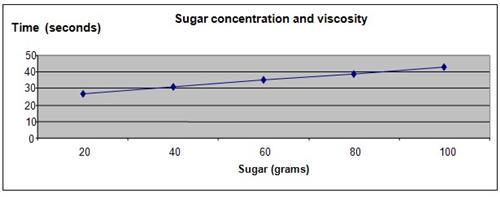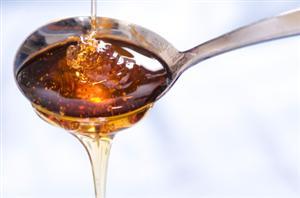| Complexity level: | 7 |
| Project cost ($): | 40 |
| Time required: | 1 hour to prepare, 2 hour for observation |
| Material availability: | You will need access to a drill and other basic tools |
| Safety concerns: | Be extremely careful when handling tools, especially power tools. The assistance of an adult is required for this. |
Hypothesis
The viscosity of water will increase when more sugar is added to the water.
Overview
Viscosity
The resistance of a fluid to any deformations that is caused by shear stress and tensile stress is known as viscosity. It also refers to the thickness of a fluid substance . A fluid with a lower viscosity is referred to as thin fluid and a fluid with a high viscosity is called a thick fluid. Viscosity can also be considered as the internal resistance that a fluid must overcome before it can flow. Fluidity is the lack of fluid resistance and the opposite of viscosity.
Viscosity in a fluid is caused by the friction between the molecules in the substance. Gasses and fluids consist of adjacent layers of molecules. When an external force or pressure acts upon the fluid, the friction between the adjacent layers of the substance will determine the deformation and flow response of the fluid.
A fluid’s viscosity is dependant on the temperature of the substance. Increasing the temperature will reduce the viscosity of the fluid and cause it to become thinner. Butter for example, is hard when kept in the refrigerator. It becomes soft at room temperature and melts to a watery consistency when heated. Cooking oil also thickens when it is kept in a refrigerator.
Scientific Terms
Materials
The materials required for this science fair project:
- 1 metal cup (>200ml)
- An electric drill with a small drill bit
- 1000ml distilled water
- 300 grams of sugar
- A measurement cylinder
- A digital weighing scale
- 5 beakers
- A stopwatch
- A spatula
- A black marker pen
Procedure
1. For this science fair project, the independent variable is the amount of sugar added to the water i.e. 20g, 40g, 60g, 80g and 100g. The dependent variable is the viscosity of the solution. This is determined by using a stopwatch to measure the rate of flow of the solution. The constants (control variables) are the size of the hole in the cup and the volume of the cup.
2. Using an electric drill, a small hole is created at the bottom of the metal cup.
3. The beakers are labeled “20g”, “40g”, “60g”, “80g” and “100g”. Using the measuring cylinder, 200ml of distilled water is poured into each of the 5 beakers.
4. The digital weighing scale is used to measure 20g, 40g, 60g, 80g and 100g batches of sugar and they are added into the beakers according to their markings. The spatula is used to mix the solution.
5. The metal cup is held up and the hole at the bottom of the metal cup is covered with 1 finger. The contents of the beaker marked “20g” is poured into the metal cup. The finger is removed from the hole and the stopwatch is immediately activated. The time taken for the cup to empty is measured and the results recorded in the table below.
6. Procedure 5 is repeated with the beakers labeled “40g”, “60g”, “80g” and “100g”.

Results
It is observed that as the concentration of sugar in the water increases, the viscosity of the solution and the time taken for it to flow out of the cup also increases.
| Amount of sugar (grams) | 20 | 40 | 60 | 80 | 100 |
| Drip time (seconds) | 27 | 31 | 35 | 39 | 43 |
Use the below graph to plot the results of our science project.

Conclusion
The hypothesis that the viscosity of water will increase when more sugar is added and mixed in water is correct.
The study of fluid dynamics and viscosity is very important when fluids like oil, gas or water is being transported over long distances through pipe lines. The changing weather, climate and temperature can alter the viscosity and flow rate of fluisd. Thus, sensors and pumps must be placed in these pipes to ensure that a constant flow rate is maintained.
Also consider
Try to repeat this science fair project by adding other substances like salt or milk powder.
The experiment can also be repeated using a different sized hole in the metal cup.
References
Viscosity - http://en.wikipedia.org/wiki/Viscosity
Specific gravity and viscosity of liquids - http://www.csgnetwork.com/sgvisc.html
What is viscosity? - http://www.wisegeek.com/what-is-viscosity.htm

